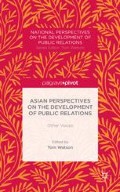Abstract
Understanding how public relations (PR) developed in the Philippines requires a thoughtful consideration of its colonial history and the influences that continue to permeate in contemporary Philippines. Outside observers would describe current public relations practice in the country as modernist, media-driven with a strong focus on corporate social responsibility (CSR). The drive to grow the industry comes from several factors: a robust media system, a democratic government, a young population of early adopters and a global outlook. This global outlook stems not only from economic reasons but also from five phases of colonial and post-independence history.
Access this chapter
Tax calculation will be finalised at checkout
Purchases are for personal use only
Preview
Unable to display preview. Download preview PDF.
References
Blount, J. H. (1912) ‘The American Occupation of the Philippines: 1898–1912’, The Project Gutenberg EBook (New York: The Knickerbocker Press).
Edgett, R. (2002) ‘Toward an Ethical Framework for Advocacy in Public Relations’, Journal of Public Relations Research, 14, 1–26.
Hutton, J. (1999) ‘The Definition, Dimensions, and Domain of Public Relations’, Public Relations Review, 25, 199–214.
Lahiri, S. (2007) ‘Rhetorical Indios: Propagandists and Their Publics in Spanish Philippines’, Comparative Studies in Society and History, 49, 243–275.
Lorenzo-Molo, M. C. F. (2006) ‘Understanding the Reputation and Image of the Philippine Public Relations Industry’, Public Relations Review, 33, 58–67.
Lorenzo-Molo, M. C. F. (2008) ‘Why Corporate Social Responsibility (CSR) Remains a Myth: The Case of the Philippines’, Asian Business & Management, 8, 149–168.
Manyozo, L. (2006) ‘Manifesto for Development Communication: Nora Quebral and the Los Baños School of Development Communication’, Asian Journal of Communication, 16, 79–99.
Manyozo, L. (2012) Media, Communication and Development: Three Approaches (New Delhi, SAGE India).
McKinley, W. (2004) ‘Compilation of the Messages and Papers of the President William McKinley, Proclamations, and Executive Orders Relating to the Spanish-American War’ in J. D. Richardson (ed.) Project Gutenberg Ebook (Salt Lake City, UT: Project Gutenberg Literary Archive Foundation).
Mojares, R. (n.d.) ‘Philippine Literature in Spanish’, http://www.ncca.gov.ph/about-culture-and-arts/articles-on-c-n-a/article.php?igm=1&i=143) (date accessed 20 November 2013).
Munshi, D (2005) ‘Postcolonial Theory and Public Relations’ in R. Heath (ed.) Encyclopedia of Public Relations (Thousand Oaks, CA: SAGE).
Nieva, R. (1993) ‘Public Relations in the Philippines’, International Public Relations Review, 16, 5–7.
Nieva, R. (1999) ‘PR Is Alive and Well and Moving Forward in the Philippines’, PR Net, 9–11.
Pineda-Ofreno, R. (1984) The Manipulated Press: A History of Philippine Journalism since 1945. (Manila: Cacho Hermanos).
Rimando, L. (2012) ‘How CSR Is Evolving in the Philippines’, Rappler, http://www.rappler.com/newsbreak/3421-how-csr-is-evolving-in-the-philippines (date accessed 5 April 2012).
Sarabia-Panol, Z. (2000) ‘Philippine Public Relations: An Industry and Practitioner Profile’, Public Relations Review, 26, 237–254.
Sarabia-Panol, Z. and Lorenzo-Molo, C. (2004) ‘Public Relations in the Philippines: A Cultural, Historical, Political and Socio-Economic Perspective’ in K. Sriramesh (ed.) Public Relations in Asia: An Anthology (Singapore: Thomson Learning).
Tan, V. and Bolante, M. P. (1997) The Synergos Institute Voluntary Sector Financing Program Case Studies of Foundation-Building in Africa, Asia and Latin America (New York: Synergos Institute).
Tiglao, R. (2012) ‘Economics of Martial Law and People Power’, Philippine Daily Inquirer, http://opinion.inquirer.net/38008/economics-of-martial-law-and-people-power (date accessed 16 January 2014).
Tilson, D. (2006) ‘Devotional-Promotional Communication and Santiago: A Thousand-Year Public Relations Campaign for Saint James and Spain’ in J. L’Etang and M. Pieczka (eds) Public Relations: Critical Debate and Contemporary Practice (Mahwah, NJ: Lawrence Erlbaum), 167–184.
Editor information
Editors and Affiliations
Copyright information
© 2014 the contributors
About this chapter
Cite this chapter
Sison, M.D., Sarabia-Panol, Z. (2014). The Philippines. In: Watson, T. (eds) Asian Perspectives on the Development of Public Relations: Other Voices. National Perspectives on the Development of Public Relations. Palgrave Pivot, London. https://doi.org/10.1057/9781137398154_8
Download citation
DOI: https://doi.org/10.1057/9781137398154_8
Publisher Name: Palgrave Pivot, London
Print ISBN: 978-1-349-48526-0
Online ISBN: 978-1-137-39815-4
eBook Packages: Palgrave Business & Management CollectionBusiness and Management (R0)

